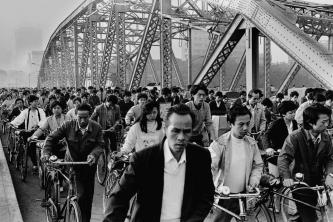
In 50 years, daily commutes, travel and migration in China have multiplied, lengthened and accelerated at a spectacular speed. A Franco-Chinese team of researchers and artists decided to explore how city dwellers feel about these changes using images as a catalyst for memories, emotions, associations of ideas and reflections. It would appear that this increase in mobility is closely associated with the imaginary of modernity and generates ambivalent feelings, ranging from enthusiasm for change to nostalgia and anxiety.
Mobility in China has been revolutionized in the past 50 years. Major public investments in transportation infrastructure, the country's economic boom, urbanization and the relaxing of state control over daily commuting, migration and travel have led to a dramatic rise in the latter, changing people’s relationship to time, place and one another. In other words, Chinese lifestyles have been turned upside down..
Urbanist-sinologist Jérémie Descamps, director of Sinapolis, a research and study office on Chinese cities, felt this mobility revolution had played a key role in how city dwellers are embracing modernity.
A research project was launched with a triple objective:
First phase
Jérémie Descamps created a multidisciplinary research team to address these questions. Together, they developed an original, multi-phase method.
Geographer Zhang Chun began by retracing changes in inter- and intra-urban travel in China from the 1950s to the present.
The team then compiled an album of 82 iconic photographs that were emblematic of these changes from the iconographic collection of Thomas Sauvin, who viewed more than a million images of China. Discover the content of this evocative album here.
Sociologist Zhou Le used this album as a starting point for sociological interviews during the field survey. She went to five of China's largest cities - Beijing, Shanghai, Wuhan, Shenzhen and Chongqing - which also happen to be key transport hubs and serve as an example for other Chinese cities. Each city has specificities, which you can discover here :
Roughly 50 city dwellers were invited to choose and comment on five to nine photographs, which activated memories, emotions, associations of ideas and thoughts on the mobility of the past, present and future. The survey thus revealed the imaginaries of modernity associated with mobility, as well as the ambivalent feelings regarding the changes.
The results of this survey inspired artist-videographer Wang Gongxin to create a piece on the theme of speed. The installation, consisting of shots – sometimes accelerated, sometimes slowed down – taken in the city and the countryside highlights the acceleration of urban lifestyles and how speed transforms our perception of reality. The web version of the work can be viewed here.
Marie Terrieux, cultural producer, sheds light on Wang Gongxin’s work in a comment:
A documentary film traces the entire process, showing how the various components were able to provide answers to the original question. By showing what went on behind the scenes during the study, it also helps highlight the difficulties that arise in multidisciplinary, transcultural projects (Franco-Chinese in this case). Finally, it shows the urban context in which the research took place through the shots taken in the various cities.
CCMMP - Images et imaginaires de la mobilité en Chine from Sinapolis on Vimeo.
Second phase
The reports produced throughout the survey were analyzed in a cross-disciplinary manner by:
Each proposes its interpretation of the results in light of their area of specialization.
A summary synthesizes Dominique Desjeux’s and Mobil'Homme’s main conclusions and also sheds light on the Chinese’s perspective through a portrait gallery that associates the texts with images.
It provided an opportunity for the Mobile Lives Forum to open a series of questions on the future of mobility in China.
A visual approach to the project is available in the Artisticlab section.
Discover the photo album revisited by sinologist-political scientist Jean-Philippe Béjà, the works of Wang Gongxin, and Thomas Sauvin, and Léo de Boissignon’s view on the role of images in the project : http://artisticlab.forumviesmobiles.org/en/mobility-in-china.
On November 9, 2017, the Mobile Lives Forum organized a conference entitled Mobility in China: following in the footsteps of the West?
Watch the videos of the conference
For the Mobile Lives Forum, mobility is understood as the process of how individuals travel across distances in order to deploy through time and space the activities that make up their lifestyles. These travel practices are embedded in socio-technical systems, produced by transport and communication industries and techniques, and by normative discourses on these practices, with considerable social, environmental and spatial impacts.
En savoir plus xPolicies
Theories
To cite this publication :
Jérémie Descamps et Thomas Sauvin (12 December 2017), « Mobility in China: A Chinese View of 50 Years of Acceleration », Préparer la transition mobilitaire. Consulté le 11 April 2025, URL: https://forumviesmobiles.org./en/project/2522/mobility-china-chinese-view-50-years-acceleration

Projects by Forum Vies Mobiles are licensed under a Creative Commons Attribution-NonCommercial-ShareAlike 3.0 France License.
Permissions beyond the scope of this license may be available at contact.
Other publications